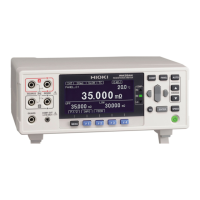4.1 Zero Adjustment
44
Perform zero-adjustment in the following circumstances:
• The measured value is not cleared due to thermal EMF or other factors.
The measured value will be adjusted to zero. (Accuracy is not affected by whether or
not the zero adjustment is performed.)
• Four-terminal connection (called Kelvin connection) is difficult.
The residual resistance of the two-terminal connection wires will be canceled.
For more information about how to perform zero-adjustment properly, see "Appendix 6 Zero
Adjustment" (p. A8).
Before Zero Adjustment
• Execute zero adjustment when the ambient temperature has changed, or when a mea-
surement lead is replaced after zero adjustment was performed. However, when perform-
ing zero-adjustment is difficult, for example when using the L2102 or L2103 Pin Type
Lead, perform zero-adjustment using the standard included L2101 Clip Type Lead or sim-
ilar lead and then switch to the pin type lead to perform measurement.
• Zero adjustment should be executed in each range to be used. Perform zero-adjustment
for the current range only when setting the range manually or for all ranges when using
auto-ranging.
• Zero adjustment values are retained internally even when the instrument is turned off.
They are also saved with panels. You can also elect not to load zero-adjustment values
from panels.
See: "6.1 Saving Measurement Conditions (Panel Save Function)"(p.72)
"6.2 Loading Measurement Conditions (Panel Load Function)"(p.73)
• Zero-adjustment can be performed even when the EXT I/O 0ADJ signal is ON (when
shorted with the EXT I/O connector’s ISO_COM pin).
• Although resistance of -3%f.s. to 50%f.s. can be canceled in each range, try to keep the
canceled resistance to 3%f.s. (f.s.=30,000dgt.) The zero-adjustment range can be
changed to TIGHT (-3%f.s. to 3%f.s.).
See: "Changing the zero-adjustment range" (p. 47)
• If a resistance that is smaller than the resistance value when zero-adjustment was per-
formed is measured, the measured value will be negative.
Example: If you set an offset of 20 m for the 300 m range
If you measure 10 m, -10 m will be displayed.
4.1 Zero Adjustment

